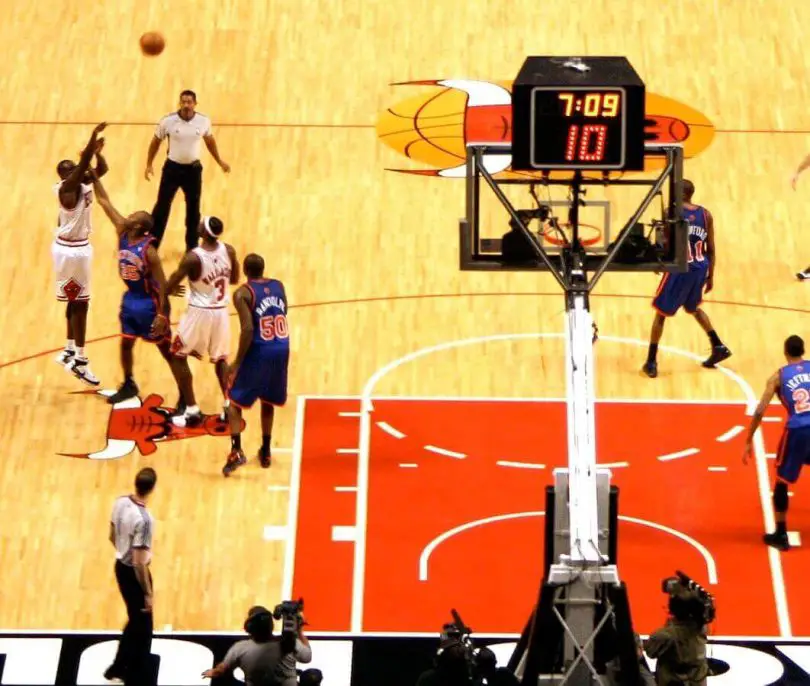Basketball is a popular sport enjoyed by millions of people worldwide. Whether you’re a seasoned player or a casual fan, you may be wondering how many quarters are in a basketball game. The answer to this question can vary depending on the level of play, but in general, most basketball games consist of four quarters.
The National Basketball Association (NBA) is the most popular basketball league globally, and its games consist of four quarters, each lasting 12 minutes. However, other leagues, such as the Women’s National Basketball Association (WNBA) and the International Basketball Federation (FIBA), have distinct regulations.
In the WNBA, games are also played in four quarters, but each quarter is only 10 minutes long. In contrast, FIBA games are played in four quarters, each lasting 10 minutes.
The Basics of Basketball Quarters
If you are new to basketball, understanding the concept of quarters is fundamental. A game of basketball is divided into four quarters, each lasting a specified amount of time. The duration of each quarter depends on the level of play and the league.
In the NBA, each quarter lasts 12 minutes, while in high school basketball, quarters are typically 8 minutes long. However, some amateur leagues may have different rules, such as only having two or three quarters, or having quarters of different lengths.
The purpose of dividing the game into quarters is to provide breaks for players and coaches to strategize and make adjustments. At the end of the first and third quarters, there is a short break, while at halftime, there is a longer break of about 15 minutes.
It is important to note that the game clock stops during certain situations, such as timeouts, fouls, and when the ball goes out of bounds. This means that the actual time it takes to complete a quarter may be longer than the specified duration.
Overall, understanding the basics of basketball quarters is essential for anyone who wants to follow the game. Knowing how long each quarter lasts and how the breaks are structured can help you better understand the flow of the game and appreciate the strategies used by teams.
The Length of a Basketball Quarter
In basketball, a quarter refers to a period of time during the game. The length of a quarter varies depending on the level of play and the league. Here is a breakdown of the length of a basketball quarter in different leagues:
- NBA, WNBA, and FIBA: 12 minutes per quarter
- High school: 8 minutes per quarter
- NCAA: 20 minutes per half (not quarters)
It is important to note that the actual time that a game lasts can be much longer than the sum of the quarters. This is due to timeouts, fouls, and other interruptions that can occur during the game.
During each quarter, teams try to score as many points as possible while defending their own basket. The team with the highest score at the conclusion of the game is declared the winner. However, if the game is tied at the end of regulation, additional overtime periods may be played to determine a winner.
Basketball quarters are an essential part of the game and provide structure and organization to the gameplay. Knowing the length of a quarter can help players and fans better understand the flow of the game and the strategies employed by the teams.
The Significance of Quarters in Basketball
In basketball, quarters are a crucial aspect of the game. They provide structure and organization, ensuring that the game runs smoothly and efficiently. Here are a few reasons why quarters are significant in basketball:
- Time Management: Quarters help in managing time during the game. Each quarter typically lasts for 12 minutes, and there are four quarters in a standard basketball game. This means that the total duration of a basketball game is 48 minutes. The clock is stopped during timeouts, free throws, and other game stoppages, ensuring that the game does not run longer than necessary.
- Strategy: Quarters also play a significant role in the strategy of the game. Coaches can use the breaks between quarters to analyze the performance of their team and make necessary adjustments. Players can also use the breaks to rest and recover, ensuring that they are fresh and energized for the next quarter.
- Fairness: Quarters ensure that both teams have an equal opportunity to perform. At the end of each quarter, the teams switch sides on the court, ensuring that neither team has an advantage due to the court’s orientation or lighting.
- Overtime: In the event of a tie at the end of regulation time, quarters also come into play. The game can go into an overtime period, which typically lasts for five minutes. If the score remains tied after the initial overtime period, further overtime periods are played until a winner is determined.
Overall, quarters provide structure, strategy, fairness, and excitement to the game of basketball. They ensure that the game runs smoothly, and both teams have an equal opportunity to perform.
Variations in Different Basketball Leagues
Different basketball leagues around the world have their own rules and regulations when it comes to the number of quarters in a game. Here are some of the variations you may encounter:
- The National Basketball Association (NBA) is the most renowned basketball league globally, and games are played in four 12-minute quarters, totaling 48 minutes of game time.The Women’s National Basketball Association (WNBA) abides by the same rules as the NBA, but with four 10-minute quarters, resulting in a total game time of 40 minutes.The International Basketball Federation (FIBA) is the worldwide governing body for basketball, and games are played in four 10-minute quarters, resulting in a total game time of 40 minutes.The National Collegiate Athletic Association (NCAA) is the governing body for college sports in the United States, and in NCAA basketball games, the game is divided into two 20-minute halves instead of four quarters.
- High School: In high school basketball games in the United States, the game is divided into four 8-minute quarters, making the total game time 32 minutes.
It’s important to note that these are just general guidelines, and there may be variations within each league depending on the specific rules of the game. It’s always a good idea to familiarize yourself with the rules of the league you’re playing in or watching to avoid confusion.
The Role of Quarters in Game Strategy
In basketball, quarters play a crucial role in the game’s strategy. Here are some ways that quarters can impact the game:
Time Management
Quarters provide a structured way to manage time during a basketball game. With each quarter lasting a set amount of time, teams can plan their plays and strategies accordingly. Coaches can also use timeouts strategically to rest their players or change their game plan.
Foul Management
Fouls can have a significant impact on the game, and quarters can help manage them. Each quarter reset the number of team fouls, allowing teams to avoid being penalized for accumulated fouls from the previous quarter. This reset can also give teams a chance to adjust their defensive strategies if they are committing too many fouls.
Momentum Shifts
Quarters can also be used to create momentum shifts in the game. If a team is struggling in one quarter, they can use the break between quarters to regroup and come back stronger in the next quarter. The start of each quarter also provides an opportunity for teams to set the tone for the rest of the game.
Player Management
Quarters can also impact how coaches manage their players. With each quarter lasting a set amount of time, coaches can plan when to give their players rest and when to play them for longer stretches. This can be especially important in close games where having fresh legs can make all the difference.
Overall, quarters play a crucial role in the game of basketball. They provide structure and fairness, help manage time and fouls, and can be used strategically to create momentum shifts and manage player fatigue.
Understanding the Clock Management
In basketball, clock management is a crucial aspect of the game. It refers to how coaches and players manage the game clock to either kill or save time in certain situations. Here are some key factors to consider when it comes to clock management:
Timeouts
Timeouts are a valuable tool for coaches to manage the clock. In the NBA, each team is given six timeouts per game, while in college basketball, each team has four timeouts per game. These timeouts can be used to stop the clock, giving teams a chance to rest, strategize, and make substitutions.
2-for-1
The 2-for-1 strategy is commonly used in basketball to save time when the clock is running low. This strategy involves a team attempting to score quickly to get the ball back and score again before the end of the quarter. This allows the team to get two possessions for the price of one, potentially giving them a significant advantage.
Game Clock
The game clock is another important aspect of clock management. In the NBA, each game is divided into four 12-minute quarters, while in college basketball, each game is divided into two 20-minute halves. In high school basketball, each game is divided into four eight-minute quarters.
It’s essential to keep an eye on the game clock and manage it effectively to ensure that the team has enough time to score while preventing the other team from doing so.
The Impact of Quarters on Player Performance
In basketball, the number of quarters can have a significant impact on player performance. The length of each quarter, as well as the number of quarters, can affect the physical and mental stamina of the players. Here are a few ways that quarters can impact player performance:
- Fatigue: The longer the quarters, the more physically demanding the game becomes. This can lead to increased fatigue, which can affect a player’s speed, agility, and accuracy. Shorter quarters can help players conserve energy and maintain their performance throughout the game.
- Momentum: The number of quarters can also affect the momentum of the game. In a game with fewer quarters, a team that falls behind early may have less time to catch up. Longer quarters can give teams more time to make a comeback or extend their lead.
- Strategy: The number of quarters can also affect a team’s strategy. In a game with fewer quarters, teams may be more aggressive early on, knowing that they have less time to make up ground. Longer quarters may allow for a more patient, strategic approach.
- Fouls: The number of quarters can also affect how players approach fouls. In a game with more quarters, players may be more cautious about committing fouls early on, knowing that they have more time to play. In a game with fewer quarters, players may be more willing to take risks and commit fouls early on.
Overall, the number of quarters in a basketball game can have a significant impact on player performance. Coaches and players must consider the length and number of quarters when developing their game plan and strategy.
Basketball Quarters: A Historical Perspective
Basketball is a sport that has evolved over time, and the way the game is played has changed as well. One of the most significant changes in the game of basketball is the way the game is divided into quarters.
In the early days of basketball, games were divided into two halves, with each half lasting 20 minutes. However, in the 1940s, the game was changed to four quarters, with each quarter lasting 12 minutes. This change was made to make the game more exciting and to increase scoring opportunities.
The four-quarter system has since become the standard for basketball games, with most professional and college-level games using this system.
However, there are still some variations in the way quarters are used in different leagues. For example, in the NBA, each quarter lasts 12 minutes, while in college basketball, each half lasts 20 minutes.
It’s interesting to note that the way quarters are used in basketball has a significant impact on the game itself. The length of each quarter determines how much time players have to score, and it can also affect the pace of the game.
Overall, the four-quarter system has become an integral part of basketball, and it’s hard to imagine the game being played any other way. It’s a testament to the evolution of the sport and the way it continues to change and adapt to new challenges and opportunities.
Conclusion
In conclusion, basketball games are divided into quarters, with each quarter lasting a specific amount of time. The number of quarters in a basketball game varies depending on the level of play and the league.
In professional basketball, there are four quarters, each lasting 12 minutes, making the total game time 48 minutes. However, the actual time it takes to play a game can be much longer due to timeouts, stoppages of play, and fouls. In the NBA, each team is given six timeouts per game, with no more than three allowed in the fourth quarter.
In NCAA basketball games, the game is divided into two 20-minute halves instead of four quarters. This structure is different from the NBA, WNBA, FIBA, and high school basketball games, which use a quarter system.
It’s important to note that the length of quarters can also vary in different leagues. For example, some international leagues may have quarters that last 10 or 15 minutes instead of 12.
It’s always a good idea to check the specific rules for the league you’re playing in or watching to ensure you have a complete understanding of the game.
Overall, understanding how many quarters are in a basketball game is essential for anyone who wants to enjoy and appreciate the game. Whether you’re a player, coach, or fan, knowing the rules and regulations of the game is crucial for a great basketball experience.







